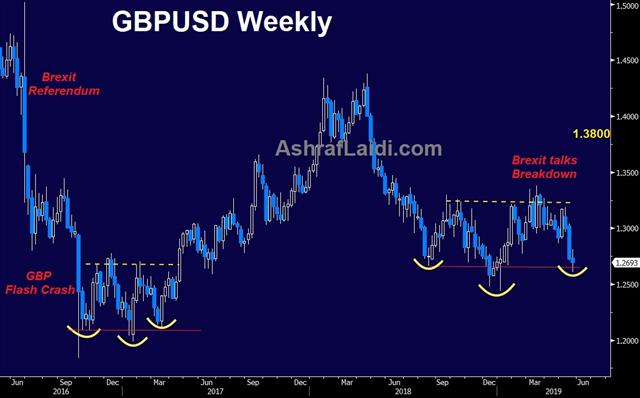After Theresa May
Now that PM Theresa May has announced stepping down from the Conservative Party leadership as of June 7, the ongoing political chaos will shift temporarily from striking a deal on the Withdrawal Agreement to reaching a winner in the Party leadership race. We know former Foreign Minister Boris Johnson is considered as the favourite to become PM with 9:4 odds. We also know too well he's a staunch Brexit supporter. But I do not foresee him as the next Prime Minister. So what's this chart telling us below?

If the inverted head-&-shoulders formation above is correct, then it suggests that we will no longer see a weekly close in GBPUSD below 1.2600. Perhaps an intraweek drop to 1.2580 or 1.2550 but not a Friday close under 1.2600. I continue to expect 1.3700 or 1.3800 before end of Q3. This includes a move of +400 pips in a single trading week within the next 3 weeks. After a series of winning trades in cable for our Premium subscribers, we were unfortunate earlier this week to have been stopped out at 1.2630 in our cable longs. Good news that quite a few clients (I call them clients not subscribers because they have been with us for some time) told me they moved or removed their stops. More importantly, keeping a clear head on the price, chart & fundamental considerations at hand is what counts to survive in this market.
For the record: We're not basing our bullish GBPUSD call solely on the inverted H&S formation. We've mentioned a few times in the Premium videos other factors such as USD considerations, macro dynamics, spreads, positioning and speculative sentiment.
Fundamentally, a rally in cable could occur via several routes: Due to Boris Johnson's staunch pro-Brexit stance and his relative indifference to a no-deal outcome, any emerging news negatively affecting his PM candidacy will be GBP-positive. An alternative Johnson scenario (GBP-positive) would be for him to secure a Brexit deal. Any path towards that would be a positive shock to the pound. There are various other options, not all of which are related to the leadership race. But the 3 major outcomes remain well on the table: Brexit with a deal, Brexit with no deal or a new general election and possibly the 4th ouctome that of a second referendum. And keep an eye on Sunday's EU elections results. A strong showing for the LibDems or a surprise +20% would be favourable for sterling bulls.
Stay tuned and don't forget the weekly close.







